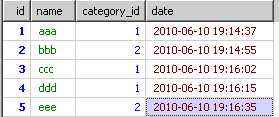标签:
引用自http://www.cnblogs.com/mo-beifeng/archive/2012/02/07/2341886.html#2341105
--按某一字段分组取最大(小)值所在行的数据
/*
数据如下:
name val memo
a 2 a2(a的第二个值)
a 1 a1--a的第一个值
a 3 a3:a的第三个值
b 1 b1--b的第一个值
b 3 b3:b的第三个值
b 2 b2b2b2b2
b 4 b4b4
b 5 b5b5b5b5b5
*/
--创建表并插入数据:
create table tb(name varchar(10),val int,memo varchar(20))
insert into tb values(‘a‘, 2, ‘a2(a的第二个值)‘)
insert into tb values(‘a‘, 1, ‘a1--a的第一个值‘)
insert into tb values(‘a‘, 3, ‘a3:a的第三个值‘)
insert into tb values(‘b‘, 1, ‘b1--b的第一个值‘)
insert into tb values(‘b‘, 3, ‘b3:b的第三个值‘)
insert into tb values(‘b‘, 2, ‘b2b2b2b2‘)
insert into tb values(‘b‘, 4, ‘b4b4‘)
insert into tb values(‘b‘, 5, ‘b5b5b5b5b5‘)
go
--一、按name分组取val最大的值所在行的数据。
--方法1:
select a.* from tb a where val = (select max(val) from tb where name = a.name) order by a.name
--方法2:
select a.* from tb a where not exists(select 1 from tb where name = a.name and val > a.val)
--方法3:
select a.* from tb a,(select name,max(val) val from tb group by name) b where a.name = b.name and a.val = b.val order by a.name
--方法4:
select a.* from tb a inner join (select name , max(val) val from tb group by name) b on a.name = b.name and a.val = b.val order by a.name
--方法5
select a.* from tb a where 1 > (select count(*) from tb where name = a.name and val > a.val ) order by a.name
/*
name val memo
---------- ----------- --------------------
a 3 a3:a的第三个值
b 5 b5b5b5b5b5
*/
本人推荐使用1,3,4,结果显示1,3,4效率相同,2,5效率差些,不过我3,4效率相同毫无疑问,1就不一样了,想不搞了。
--二、按name分组取val最小的值所在行的数据。
--方法1:
select a.* from tb a where val = (select min(val) from tb where name = a.name) order by a.name
--方法2:
select a.* from tb a where not exists(select 1 from tb where name = a.name and val < a.val)
--方法3:
select a.* from tb a,(select name,min(val) val from tb group by name) b where a.name = b.name and a.val = b.val order by a.name
--方法4:
select a.* from tb a inner join (select name , min(val) val from tb group by name) b on a.name = b.name and a.val = b.val order by a.name
--方法5
select a.* from tb a where 1 > (select count(*) from tb where name = a.name and val < a.val) order by a.name
/*
name val memo
---------- ----------- --------------------
a 1 a1--a的第一个值
b 1 b1--b的第一个值
*/
--三、按name分组取第一次出现的行所在的数据。
select a.* from tb a where val = (select top 1 val from tb where name = a.name) order by a.name
/*
name val memo
---------- ----------- --------------------
a 2 a2(a的第二个值)
b 1 b1--b的第一个值
*/
--四、按name分组随机取一条数据。
select a.* from tb a where val = (select top 1 val from tb where name = a.name order by newid()) order by a.name
/*
name val memo
---------- ----------- --------------------
a 1 a1--a的第一个值
b 5 b5b5b5b5b5
*/
--五、按name分组取最小的两个(N个)val
select a.* from tb a where 2 > (select count(*) from tb where name = a.name and val < a.val ) order by a.name,a.val
select a.* from tb a where val in (select top 2 val from tb where name=a.name order by val) order by a.name,a.val
select a.* from tb a where exists (select count(*) from tb where name = a.name and val < a.val having Count(*) < 2) order by a.name
/*
name val memo
---------- ----------- --------------------
a 1 a1--a的第一个值
a 2 a2(a的第二个值)
b 1 b1--b的第一个值
b 2 b2b2b2b2
*/
--六、按name分组取最大的两个(N个)val
select a.* from tb a where 2 > (select count(*) from tb where name = a.name and val > a.val ) order by a.name,a.val
select a.* from tb a where val in (select top 2 val from tb where name=a.name order by val desc) order by a.name,a.val
select a.* from tb a where exists (select count(*) from tb where name = a.name and val > a.val having Count(*) < 2) order by a.name
/*
name val memo
---------- ----------- --------------------
a 2 a2(a的第二个值)
a 3 a3:a的第三个值
b 4 b4b4
b 5 b5b5b5b5b5
*/
--七,假如整行数据有重复,所有的列都相同(例如下表中的第5,6两行数据完全相同)。
按name分组取最大的两个(N个)val
1 /*
2 数据如下:
3 name val memo
4 a 2 a2(a的第二个值)
5 a 1 a1--a的第一个值
6 a 1 a1--a的第一个值
7 a 3 a3:a的第三个值
8 a 3 a3:a的第三个值
9 b 1 b1--b的第一个值
10 b 3 b3:b的第三个值
11 b 2 b2b2b2b2
12 b 4 b4b4
13 b 5 b5b5b5b5b5
14
15 */
16
附:mysql “group by ”与"order by"的研究--分类中最新的内容
这两天让一个数据查询难了。主要是对group by 理解的不够深入。才出现这样的情况
这种需求,我想很多人都遇到过。下面是我模拟我的内容表

我现在需要取出每个分类中最新的内容
select * from test group by category_id order by `date`
结果如下

明显。这不是我想要的数据,原因是msyql已经的执行顺序是
引用
写的顺序:select ... from... where.... group by... having... order by..
执行顺序:from... where...group by... having.... select ... order by...
所以在order by拿到的结果里已经是分组的完的最后结果。
由from到where的结果如下的内容。

到group by时就得到了根据category_id分出来的多个小组


到了select的时候,只从上面的每个组里取第一条信息结果会如下

即使order by也只是从上面的结果里进行排序。并不是每个分类的最新信息。
回到我的目的上 --分类中最新的信息
根据上面的分析,group by到select时只取到分组里的第一条信息。有两个解决方法
1,where+group by(对小组进行排序)
2,从form返回的数据下手脚(即用子查询)
由where+group by的解决方法对group by里的小组进行排序的函数我只查到group_concat()可以进行排序,但group_concat的作用是将小组里的字段里的值进行串联起来。
select group_concat(id order by `date` desc) from `test` group by category_id

再改进一下
select * from `test` where id in(select SUBSTRING_INDEX(group_concat(id order by `date` desc),‘,‘,1) from `test` group by category_id ) order by `date` desc
 子查询解决方案
子查询解决方案
select * from (select * from `test` order by `date` desc) `temp` group by category_id order by `date` desc

mysql中 groupby分组
标签:
原文地址:http://www.cnblogs.com/liuwenbohhh/p/4321016.html







